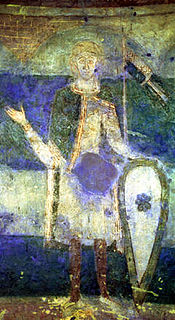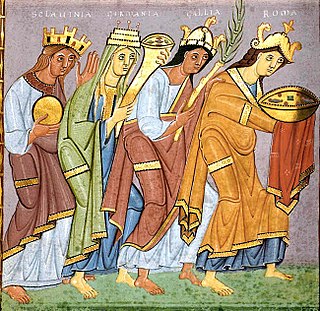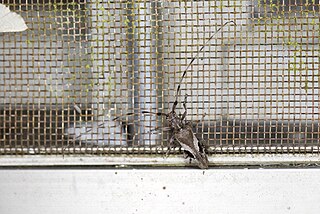Related Research Articles

The Curta is a hand-held mechanical calculator designed by Curt Herzstark. It is known for its extremely compact design: a small cylinder that fits in the palm of the hand. It was affectionately known as the "pepper grinder" or "peppermill" due to its shape and means of operation; its superficial resemblance to a certain type of hand grenade also earned it the nickname "math grenade".

Samo founded the first recorded political union of Slavic tribes, known as Samo's Empire, stretching from Silesia to present-day Slovenia, ruling from 623 until his death in 658. According to Fredegarius, the only contemporary source, Samo was a Frankish merchant who unified several Slavic tribes against robber raids and violence by nearby settled Avars, showing such bravery and command skills in battle that he was elected as the "Slavic king". In 631, Samo successfully defended his realm against the Frankish Kingdom in the three-day Battle of Wogastisburg.

The Early Middle Ages in Romania started with the withdrawal of the Roman troops and administration from Dacia province in the 270s. In the next millennium a series of peoples, most of whom only controlled two or three of the nearly ten historical regions that now form Romania, arrived. During this period, society and culture underwent fundamental changes. Town life came to an end in Dacia with the Roman withdrawal, and in Scythia Minor – the other Roman province in the territory of present-day Romania – 400 years later. Fine vessels made on fast potter's wheels disappeared and hand-made pottery became dominant from the 450s. Burial rites changed more than once from cremation to inhumation and vice versa until inhumation became dominant by the end of the 10th century.

The Sclaveni or Sklabenoi were early Slavic tribes that raided, invaded and settled the Balkans in the Early Middle Ages and eventually became known as the ethnogenesis of the South Slavs. They were mentioned by early Byzantine chroniclers as barbarians having appeared at the Byzantine borders along with the Antes, another Slavic group. The Sclaveni were differentiated from the Antes and Wends ; however, they were described as kin. Eventually, most South Slavic tribes accepted Byzantine suzerainty, and came under Byzantine cultural influence. The term was widely used as general catch-all term until the emergence of separate tribal names by the 10th century.

Regina Maria Loureiro Barreto Casé is a Brazilian actress, screenwriter, director, producer, and television presenter.

The Antes, or Antae, were an early East Slavic tribal polity of the 6th century CE. They lived on the lower Danube River, in the northwestern Black Sea region, and in the regions around the Don River. Scholars commonly associate the Antes with the archaeological Penkovka culture.

The early Slavs were a diverse group of tribal societies who lived during the Migration Period and the Early Middle Ages in Central and Eastern Europe and established the foundations for the Slavic nations through the Slavic states of the High Middle Ages. The first written use of the name "Slavs" dates to the 6th century, when the Slavic tribes inhabited a large portion of Central and Eastern Europe. By then, the nomadic Iranian ethnic groups living on the Eurasian Steppe had been absorbed by the region's Slavic population. Over the next two centuries, the Slavs expanded southwest toward the Balkans and the Alps and northeast towards the Volga River. The Slavs' original habitation is still a matter of controversy, but scholars believe that it was somewhere in Eastern Europe.
Florin Curta is a Romanian-born American archaeologist and historian who is a Professor of Medieval History and Archaeology at the University of Florida.
Zicídeva was an Early Byzantine town, tentatively identified with the late antique settlement excavated on the top of Tsarevets hill, near modern Veliko Tarnovo in northern Bulgaria.
Uraecha guerryi is a species of beetle in the family Cerambycidae. It was described by Maurice Pic in 1903, originally under the genus Eryssamena. It is known from China.
Uraecha albovittata is a species of beetle in the family Cerambycidae. It was described by Stephan von Breuning in 1956. It is known from China.
Uraecha ochreomarmorata is a species of beetle in the family Cerambycidae. It was described by Stephan von Breuning in 1965. It is known from Laos.
Uraecha oshimana is a species of beetle in the family Cerambycidae. It was described by Stephan von Breuning in 1954. It is known from Japan.
Uraecha yunnana is a species of beetle in the family Cerambycidae. It was described by Judson Linsley Gressitt in 1942. It is known from China.

Uraecha angusta is a species of beetle in the family Cerambycidae. It was described by Francis Polkinghorne Pascoe in 1856, originally under the genus Monohammus. It is known from Vietnam, China and Taiwan. It contains the varietas Uraecha angusta var. horishana.

Uraecha bimaculata is a species of beetle in the family Cerambycidae. It was described by James Thomson in 1864.
Uraecha gilva is a species of beetle in the family Cerambycidae. It was described by Yokoyama in 1966.
Uraecha obliquefasciata is a species of beetle in the family Cerambycidae. It was described by Chiang in 1951. It is known from China.
Uraecha punctata is a species of beetle in the family Cerambycidae. It was described by Charles Joseph Gahan in 1888. It is known from India and Vietnam.
The history of Christianity in Hungary started in the Roman province of Pannonia, centuries before the arrival of the Magyars, or Hungarians.
References
- ↑ BioLib.cz - Uraecha curta. Retrieved on 8 September 2014.